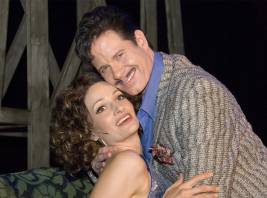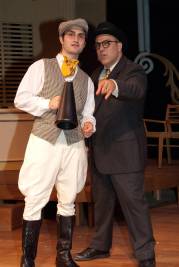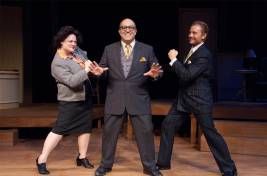RECOMMENDED
Screen legend Greta Garbo’s voice remained as mysterious as the star herself until the release of Anna Christie, her first talking picture. “Garbo Talks!” proclaimed ads for the 1930 flick, and talk the Swedish superstar did, her “Gif me a vhisky, ginger ale on the side, and don’t be stingy, baby!” soon becoming almost as synonymous with the reclusive screen idol as her much quoted “I vant to be alone!”
When Garbo Talks, a new musical, looks back at Garbo in the 1920s, from her discovery in her native land by director Mauritz Stiller, to her arrival in Hollywood at the invitation of MGM mogul Louis B. Mayer, to her romance with matinee idol John Gilbert, to the filming of Anna Christie and the beginning of Garbo’s decade as an honest-to-goodness talking movie star.
Now getting its World Premiere Production at Long Beach’s International City Theatre, When Garbo Talks, though not as successful as the season-opening Backwards In High Heels (the Ginger Rogers musical), nonetheless has much to recommend in it, first and foremost the performances of its uniformly topnotch cast and the as always solid direction of Jules Aaron.
Whereas Ginger Rogers’ life was a natural for a song-and-dance show, Garbo’s proves not quite as apt, though Aaron, his cast, and choreographer Kay Cole do their darnedest to keep their audience entertained. The late Buddy Kaye’s book, though formulaic as most show biz bios tend to be, does give us an interesting, informative behind-the-scenes look, both at the birth of a star and at the “Golden Age Of Hollywood” milieu that beckoned her from her native land. Kaye’s lyrics are clever, as befits the man who penned “‘A’ — You’re Adorable (The Alphabet Song)” and numerous other 1940s-1980s hits. (Richard D. Kaye, the book-writer/lyricist’s son and the production’s honorary associate producer has contributed additional book.) Only the late Mort Garson’s lackluster melodies prove insufficiently “hummable” to propel the musical to post-World Premiere success.
Act One introduces us to Greta Gustafsson, a tall, big-footed, slightly heavy aspiring actress who appears to have little in common with the legend we know as Garbo. Fortunately, all young Greta (Jessica Burrows) needs is “Someone To Believe In Me,” and that is exactly what she finds, first in best friend Signe (Alexandra Ackerman) and then in “Moshe” Stiller (Michael Stone Forrest), who guides “My Protégé” to screen success in her homeland. “A Little Bitty City Called Hollywood” soon comes calling in the persons of Louis B. Mayer (Matthew Henerson) and his loyal employees Ida (Teya Pitt) and Eddie (Nick Rogers). Hollywood’s decision to “totally redo” Garbo means losing that baby fat, taming those fly-away curls, and finding a way to shrink those feet. (Well, two out of three isn’t bad.) As Greta and Moshe soon learn, Hollywood is not Stockholm, and the pair come to the conclusion that “It Was A Mistake.” If only they hadn’t signed those ironclad MGM contracts.
When Garbo Talks’ first act is not without its charms, but it’s not until Act Two that the musical really takes off, John Gilbert (Christopher Carothers) entering Greta’s life, Moshe leaving it, and Louis B. Mayer making sure that the star he created remains the property of the studio that bears his family name. Burrows’ Garbo gets several second act ballads that showcase her glorious soprano and Henerson, Rogers, and Patt get to stop the show, first with Louis’ and Eddie’s “the Great Garbo Must Go,” then with Eddie’s and Ida’s “The Silent Picture Days.”
Performances reflect the heightened acting style of the era rather that the more natural style contemporary audiences are accustomed to, but the larger, more dramatic line readings and gestures seem not inappropriate given the time these people lived in.
Burrows makes for a gorgeous, glamorous Garbp, transitioning believably from ugly duckling to gorgeous swan, and her singing is (in a word) heavenly. It’s exciting too to see this now New York-based performer back in her native Southern California, where she graced the stages of Performance Riverside, the Pasadena Playhouse, the Ahmanson, and the La Jolla Playhouse earlier in her career.
Forrest, a recent Scenie winner for his powerful work as Sweeney Todd, makes a vivid impression as the openly gay Stiller. (“You know of my affairs with men,” he tells Garbo, who responds ruefully, “I thought we could overcome that.”) Like Burrows, Stone’s singing is superb.
Henerson is the featured cast standout, brash, bossy, full of himself, and a laugh-getter as megalomaniacal movie mogul Mayer, with Rogers and Patt providing snappy support as his fawning lackeys Eddie and Ida. Christopher Carothers disappears into the skin of silent screen legend Gilbert, Ackerman is a touching Signe (who shares a brief Sapphic kiss with Burrows), and Scott Kruse is versatility personified as a buff, shirtless Nick, flamboyant film director Clarence Brown, and a frustrated Minister Andrews.
Musical director Brent Crayon on piano conducts the production’s excellent five-piece orchestra (Oliver Steinberg on bass, Eli Hiudzik on drums, Adrienne Geffen on woodwinds, and Billy Thompson on keyboard). Stephen Gifford’s imaginative scenic design permits multiple locales on a set which resembles a 1920s movie lot. Debra Garcia Lockwood gets high marks for her varied lighting design as does Kim DeShazo for her excellent period costumes. Hair and wig design is by Anthony Gagliardi and resident properties designers Patty and Gordon Briles merit kudos for their attention to detail. Despite a mike malfunction which marred Forrest’s early scenes, Joseph “Sloe” Slawinski has contributed an effective sound design. Maya M. Rodgers is resident stage manager.
With catchier melodies, When Garbo Talks might well go on to future success, its relatively small cast and orchestra making it a natural for regional theaters. As it stands, the show lacks that key element that separates an entertaining musical from one that makes audiences want to return again and again. Fortunately, the talent of its cast and the ICT team go a long way towards making When Garbo Talks as enjoyable as it is.
International City Theatre, Long Beach Performing Arts Center, 300 E. Ocean Blvd., Long Beach.
www.InternationalCityTheatre.org
–Steven Stanley
October 15, 2010
Photos: Shashin Desai





 Since 2007, Steven Stanley's StageSceneLA.com has spotlighted the best in Southern California theater via reviews, interviews, and its annual StageSceneLA Scenies.
Since 2007, Steven Stanley's StageSceneLA.com has spotlighted the best in Southern California theater via reviews, interviews, and its annual StageSceneLA Scenies.







 COPYRIGHT 2024 STEVEN STANLEY :: DESIGN BY
COPYRIGHT 2024 STEVEN STANLEY :: DESIGN BY